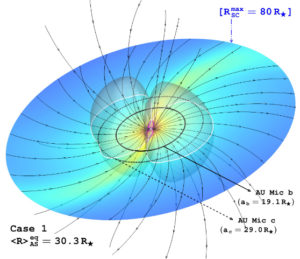Paper on AU Mic’s space weather

A new study by our Schwarzschild Fellow Dr. Julián Alvarado-Gomez shows that the space weather of AU Mic makes the survival of exoplanet atmospheres very challenging.
Simulating the Space Weather in the AU Mic System: Stellar Winds and Extreme Coronal Mass Ejections
Alvarado-Gómez, Julián D.; Cohen, Ofer; Drake, Jeremy J.; Fraschetti, Federico; Poppenhaeger, Katja; Garraffo, Cecilia; Chebly, Judy; Ilin, Ekaterina; Harbach, Laura; Kochukhov, Oleg
Two close-in planets have been recently found around the M-dwarf flare star AU Microscopii (AU Mic). These Neptune-sized planets (AU Mic b and c) seem to be located very close to the so-called “evaporation valley” in the exoplanet population, making this system an important target for studying atmospheric loss on exoplanets. This process, while mainly driven by high-energy stellar radiation, will be strongly mediated by the space environment surrounding the planets. Here we present an investigation of this last area, performing 3D numerical modeling of the quiescent stellar wind from AU Mic, as well as time-dependent simulations describing the evolution of a highly energetic coronal mass ejection (CME) event in this system. Observational constraints on the stellar magnetic field and properties of the eruption are incorporated in our models. We carry out qualitative and quantitative characterizations of the stellar wind, the emerging CMEs, as well as the expected steady and transient conditions along the orbit of both exoplanets. Our results predict extreme space weather for AU Mic and its planets. This includes sub-Alfvénic regions for the large majority of the exoplanet orbits, very high dynamic and magnetic pressure values in quiescence (varying within 102-105 times the dynamic pressure experienced by Earth), and an even harsher environment during the passage of any escaping CME associated with the frequent flaring observed in AU Mic. These space weather conditions alone pose an immense challenge for the survival of exoplanetary atmospheres (if any) in this system.
The Astrophysical Journal, Volume 928, Issue 2, id.147, 12 pp., April 2022